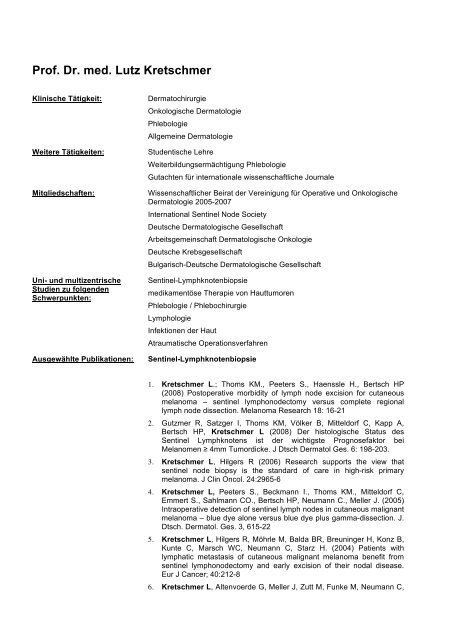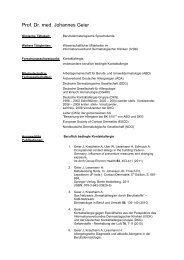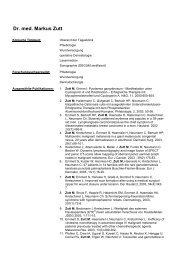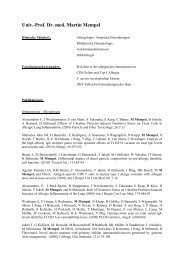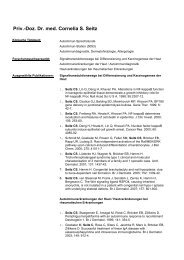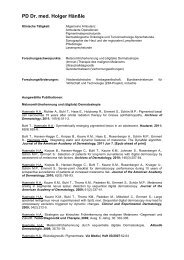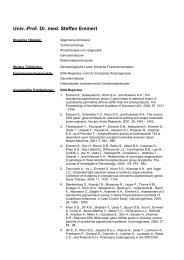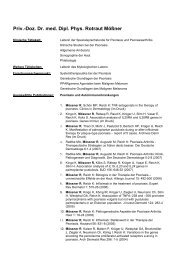Prof. Dr. med. Lutz Kretschmer
Prof. Dr. med. Lutz Kretschmer
Prof. Dr. med. Lutz Kretschmer
You also want an ePaper? Increase the reach of your titles
YUMPU automatically turns print PDFs into web optimized ePapers that Google loves.
<strong>Prof</strong>. <strong>Dr</strong>. <strong>med</strong>. <strong>Lutz</strong> <strong>Kretschmer</strong><br />
Klinische Tätigkeit:<br />
Weitere Tätigkeiten:<br />
Mitgliedschaften:<br />
Uni- und multizentrische<br />
Studien zu folgenden<br />
Schwerpunkten:<br />
Ausgewählte Publikationen:<br />
Dermatochirurgie<br />
Onkologische Dermatologie<br />
Phlebologie<br />
Allgemeine Dermatologie<br />
Studentische Lehre<br />
Weiterbildungsermächtigung Phlebologie<br />
Gutachten für internationale wissenschaftliche Journale<br />
Wissenschaftlicher Beirat der Vereinigung für Operative und Onkologische<br />
Dermatologie 2005-2007<br />
International Sentinel Node Society<br />
Deutsche Dermatologische Gesellschaft<br />
Arbeitsgemeinschaft Dermatologische Onkologie<br />
Deutsche Krebsgesellschaft<br />
Bulgarisch-Deutsche Dermatologische Gesellschaft<br />
Sentinel-Lymphknotenbiopsie<br />
<strong>med</strong>ikamentöse Therapie von Hauttumoren<br />
Phlebologie / Phlebochirurgie<br />
Lymphologie<br />
Infektionen der Haut<br />
Atraumatische Operationsverfahren<br />
Sentinel-Lymphknotenbiopsie<br />
1. <strong>Kretschmer</strong> L.; Thoms KM., Peeters S., Haenssle H., Bertsch HP<br />
(2008) Postoperative morbidity of lymph node excision for cutaneous<br />
melanoma – sentinel lymphonodectomy versus complete regional<br />
lymph node dissection. Melanoma Research 18: 16-21<br />
2. Gutzmer R, Satzger I, Thoms KM, Völker B, Mitteldorf C, Kapp A,<br />
Bertsch HP, <strong>Kretschmer</strong> L (2008) Der histologische Status des<br />
Sentinel Lymphknotens ist der wichtigste Prognosefaktor bei<br />
Melanomen ≥ 4mm Tumordicke. J Dtsch Dermatol Ges. 6: 198-203.<br />
3. <strong>Kretschmer</strong> L, Hilgers R (2006) Research supports the view that<br />
sentinel node biopsy is the standard of care in high-risk primary<br />
melanoma. J Clin Oncol. 24:2965-6<br />
4. <strong>Kretschmer</strong> L, Peeters S., Beckmann I., Thoms KM., Mitteldorf C,<br />
Emmert S., Sahlmann CO., Bertsch HP, Neumann C., Meller J. (2005)<br />
Intraoperative detection of sentinel lymph nodes in cutaneous malignant<br />
melanoma – blue dye alone versus blue dye plus gamma-dissection. J.<br />
Dtsch. Dermatol. Ges. 3, 615-22<br />
5. <strong>Kretschmer</strong> L, Hilgers R, Möhrle M, Balda BR, Breuninger H, Konz B,<br />
Kunte C, Marsch WC, Neumann C, Starz H. (2004) Patients with<br />
lymphatic metastasis of cutaneous malignant melanoma benefit from<br />
sentinel lymphonodectomy and early excision of their nodal disease.<br />
Eur J Cancer; 40:212-8<br />
6. <strong>Kretschmer</strong> L, Altenvoerde G, Meller J, Zutt M, Funke M, Neumann C,
Becker W (2003) Dynamic lymphscintigraphy and image fusion of<br />
SPECT and pelvic CT-scans allow mapping of aberrant pelvic sentinel<br />
lymph nodes in malignant melanoma. Eur. J. Cancer 39, 175-83<br />
7. <strong>Kretschmer</strong> L, Bertsch HP, Meller J (2003) Sentinel-<br />
Lymphonodektomie beim malignen Melanom - ein Update. Journal der<br />
Deutschen Dermatologischen Gesellschaft 1: 777-84<br />
8. <strong>Kretschmer</strong> L, Neumann C (2002): Sentinel node technique will<br />
change the design of clinical trials in malignant melanoma. J Clin Oncol<br />
20, 2208-10<br />
Lymphknotenmetastasierung beim malignen Melanom<br />
1. <strong>Kretschmer</strong> L, Preußer KP (2001): Standardized axillary<br />
lymphadenectomy improves local control but not survival in patients<br />
with palpable lymph node metastases of cutaneous malignant<br />
melanoma. Langenbecks Arch Surg 386, 418-27<br />
2. <strong>Kretschmer</strong> L, Neumann C, Preußer KP, Marsch WC (2001):<br />
Superficial Inguinal and Radical Ilioinguinal Lymph Node Dissection in<br />
Patients with Palpable Melanoma Metastases to the Groin – an Analysis<br />
of Survival and Local Recurrence. Acta Oncol 40, 72-78<br />
3. <strong>Kretschmer</strong> L, Marsch WC, Neumann C (2000): In regard to: Lee RJ,<br />
et al. Nodal basin recurrence following lymph node dissection for<br />
melanoma: implications for adjuvant radiotherapy. Int J Radiat Oncol<br />
Biol Phys. 48, 1267-8<br />
4. <strong>Kretschmer</strong> L, Preußer KP, Marsch WC, Neumann C (2000):<br />
Prognostic factors of overall survival in patients with delayed lymph<br />
node dissection for cutaneous malignant melanoma. Melanoma Res 10,<br />
483-489<br />
5. <strong>Kretschmer</strong> L, Lautenschläger C, Preußer KP, Fiedler H, Hetschko I<br />
(1993): Das axilläre Rezidiv nach Lymphadenektomie beim malignen<br />
Melanom. Langenbecks Arch Chir 378, 4-11<br />
6. <strong>Kretschmer</strong> L, Lautenschläger C, Preußer KP, Fiedler H (1993): Das<br />
inguinale Rezidiv nach therapeutischer Lymphadenektomie beim<br />
malignen Melanom. Langenbecks Arch Chir 378, 211-216<br />
7. In-transit-Hautmetastasen maligner Melanome<br />
8. <strong>Kretschmer</strong> L, Beckmann I, Thoms KM, Mitteldorf C, Bertsch HP,<br />
Neumann C (2006) Factors predicting the risk of in-transit recurrence<br />
after sentinel lymphonodectomy in patients with cutaneous malignant<br />
melanoma. Ann Surg Oncol. 13:1105-12.<br />
9. <strong>Kretschmer</strong> L, Beckmann I, Thoms KM, H. Haenssle, Bertsch HP,<br />
Neumann Ch (2005) Sentinel lymphonodectomy does not increase the<br />
risk of locoregional cutaneous metastases of malignant melanomas. Eur<br />
J Cancer 41:531-8.<br />
10. <strong>Kretschmer</strong> L, Beckmann I, Thoms KM, H. Haenssle, Bertsch HP,<br />
Neumann Ch (2005) High incidence of in-transit metastases after<br />
sentinel node biopsy in patients with melanoma. Br J Surg 31, 253-4<br />
11. <strong>Kretschmer</strong> L, Preußer KP, Neumann C (2002): Locoregional<br />
cutaneous metastases in patients with therapeutic lymph node<br />
dissection for malignant melanoma: risk factors and prognostic impact.<br />
Melanoma Res 12:499-504<br />
12. Medikamentöse Therapie von Hauttumoren<br />
13. Kaufmann R, Spieth K, Leiter U, Mauch C, von den <strong>Dr</strong>iesch P, Vogt T,<br />
Linse R, Tilgen W, Schadendorf D, Becker JC, Sebastian G, Krengel S,<br />
<strong>Kretschmer</strong> L, Garbe C, Dummer R (2005) Temozolomide in
combination with interferon-alfa versus temozolomide alone in patients<br />
with advanced metastatic melanoma: a randomized, phase III,<br />
multicenter study from the Dermatologic Cooperative Oncology Group.<br />
J Clin Oncol. 23:9001-7<br />
14. Emmert S, Zutt M, Haenssle H, Neumann C, <strong>Kretschmer</strong> L (2003)<br />
Inefficacy of vindesine monotherapy in advanced stage IV malignant<br />
melanoma patients previously treated with other chemotherapeutic<br />
agents. Melanoma Res 13:299-302<br />
15. <strong>Kretschmer</strong> L, Helmbold P, Emmert S, Neumann C, Marsch WC<br />
(2002): Langzeitergebnisse der adjuvanten Chemotherapie nach<br />
therapeutischer Lymphknotendissektion beim malignen Melanom der<br />
Haut. Hautarzt 53, 536-541<br />
16. <strong>Kretschmer</strong> L (2001): Adjuvant chemotherapy in patients with palpable<br />
lymph node metastases in cutaneous malignant melanoma. Melanoma<br />
Res 11, 315-318<br />
Infektionen der Haut<br />
1. Zutt M, Zimmermann O, Krüger U, <strong>Kretschmer</strong> L (2003) Operative<br />
Sanierung florider venöser Ulcera – Wundinfektionsrate unter<br />
Anbtibiogramm-orientierter perioperativer Prophylaxe. Phlebologie<br />
2003; 32: 121-6.<br />
2. <strong>Kretschmer</strong> L, Zimmermann O, Stein A, Sebastian G (2001):<br />
Perioperative Antibiotikatherapie in der Dermatologie. Hautarzt 7, 609-<br />
614<br />
Venenchirurgie – Ulcus cruris<br />
1. Grattenthaler C, Thoms KM, <strong>Kretschmer</strong> L (2007) Paratibiale<br />
Fasziotomie beim Ulcus cruris postthromboticum mit dem Fasziotom<br />
nach Volkmar. J Dtsch Dermatol Ges. 5:1144-5.<br />
2. <strong>Kretschmer</strong> L, Cornely M, Preusser KP: Rezidivprophylaxe beim Ulcus<br />
cruris venosum durch eine umfassende Ausschöpfung operativer<br />
Therapiemöglichkeiten. Fortschritte der operativen und onkologischen<br />
Dermatologie 10, hrsg v. Tilgen W, Petzold D; Springer, Berlin-<br />
Heidelberg-New York, 1995, 116-120


